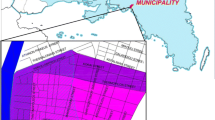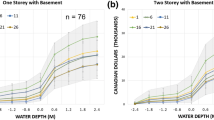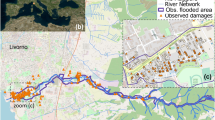Abstract
The paper presents a new integrated model for the ex-ante evaluation of flood Expected Annual Damage (EAD) with specific reference to the direct damage to residential buildings. Starting from the analysis of an existing flood-damage model developed in other contexts, we propose an integrated evaluation model based on the definition of an analytic “stage damage curve” for different typology of residential buildings. The model is based on the integration of hydraulic model, combined with an ex-ante damage evaluation model, as a decision-support tool for sustainable risk management. Finally, combining hazard and vulnerability levels by using a GIS-based toolbox, the EAD to an urban area is obtained. The proposed model is then tested in a residential urban area of the municipality of Olbia in Italy, which was damaged by the extraordinary flood on November 2013. The comparison, between the ex-post assessed damage and the ex-ante evaluation based on the application of the model, enables to verify high reliability of the results obtained.
Access this chapter
Tax calculation will be finalised at checkout
Purchases are for personal use only
Similar content being viewed by others
References
Bubeck P, Kreibich H (2011) Natural hazards: direct costs and losses due to the disruption of production processes. CONHAZ Report. http://conhaz.org/CONHAZ%20REPORT%20WP012.pdf
DEFRA/EA (2006) Flood risks to people. Phase 2. The flood risks to people methodology. Flood and Coastal Defence R&D Programme, London, UK
De Moel H, Aerts JCJH (2011) Effect of uncertainty in land use, damage models and inundation depth on flood damage estimates. Nat Hazards 58(1):407–425
Ebert A, Kerle N, Stein A (2009) Urban social vulnerability as—assessment with physical proxies and spatial metrics derived from air- and spaceborne imagery and GIS data. Nat Hazards 48:275–294
EC, European Commission (2007) EU Directive of the European Parliament and of the European Council on the estimation and management of flood risks, 2007/60/EU. European Commission, Brussels, Belgium
FEMA (Federal Emergency Management Agency) (2003) HAZUS-MH Technical Manual. Washington, DC: FEMA, Department of Homeland, Technical Report
FEMA (2009) HAZUS-MH MR4 flood model technical manual
Haque C, Etkin D (2007) People and community as constituent parts of hazards: the significance of societal dimensions in hazards analysis. Nat Hazards 41:271–282
ISPRA Istituto Superiore per la Protezione e la Ricerca Ambientale (2012) Proposta metodologica per l’aggiornamento delle mappe di pericolosità e di rischio, Rapporto 82/2012
Joint Research Centre EU (2013) Overview of disaster risk that the EU faces, JRC Scientific and policy report, 2013
Jongman B, Kreibich H, Apel H, Barredo JI, Bates PD, Feyen L, Gericke A, Neal J, Aerts JCJH, Ward PJ (2012) Comparative flood damage model assessment: towards a European approach. Nat Hazards Earth Syst Sci 12:3733–3752. Doi:10.5194/nhess-12-3733-2012
Kreibich H, Seifert I, Merz B, Thieken AH (2010) Development of flemocs—a new model for the estimation of flood losses in the commercial sector. Hydrol Sci J 55:1302–1314. doi:10.1080/02626667.2010.529815
Krysanova V, Buiteveld H, Haase D, Hattermann FF, Van Niekerk K, Roest K, Martınez-Santos P, Schlüter M (2008) Practices and lessons learned in coping with climatic hazards at the river-basin scale: floods and droughts. Ecol Soc 13(2):32
Kubal C, Haase D, Meyer V, Scheuer S (2009) Integrated urban flood risk assessment—adapting a multicriteria approach to a city Nat. Hazards Earth Syst Sci 9:1881–1895
Manganelli B (2011) Il deprezzamento degli immobili urbani. Franco Angeli Editore
Merz B, Kreibich H, Thieken A, Schmidtke R (2004) Estimation uncertainty of direct monetary flood damage to buildings. Nat Hazards Earth Syst Sci 4:153–163
Messner F, Penning-Rowsell E, Green C, Meyer V, Tunstall S, van der Veen A (2007) Evaluating flood damages: guidance and recommendations on principles and methods, FLOODsite—Report T09-06-01, 176 pp
Meyer V, Scheuer S, Haase D (2009) A multicriteria approach for flood risk mapping exemplified at the Mulde River, Germany. Nat Hazards 48:17–39
Molinari D, Ballio F, Menoni S, Handmer J (2014) On the modeling of significance for flood damage assessment. Int J Disaster Risk Reduction 10:381–391 Elsevier Ltd
Penning-Rowsell EC, Chatterton JB (1977) The benefits of flood alleviation: a manual of assessment techniques. Gower Technical Press, Aldershot, UK
Penning-Rowsell EC, Viavattene E, Pardoe J, Chatterton J, Parker D, Morris J (2010) The benefits of flood and coastal risk management: A handbook of assessment techniques—2010. Flood Hazard Research Centre, Middlesex University Press, London
Przyluski V, Hallegatte S (2011) Indirect costs of natural hazards. CONHAZ Report. http://conhaz.org/CONHAZ%20REPORT%20WP022FINAL.pdf
Thieken AH, Ackermann V, Elmer F, Kreibich H, Kuhlmann B, Kunert U, Maiwald H, Merz B, Muller M, Piroth K, Schwarz J, Schwarze R, Seifert I, Seifert J (2008) Methods for the evaluation of direct and indirect flood losses. In: 4th international symposium on flood defense: managing flood risk, reliability and vulnerability. Toronto, Ontario, Canada, 6–8 May 2008
Vanneuville W, Maddens R, Collard C, Bogaert P, De Maeyer P, Antrop M (2006) Impact op mens en economie t.g.v. overstrom- ingen bekeken in het licht van wijzigende hydraulische condities, omgevingsfactoren en klimatologische omstandigheden. MIRA/ 2006/02, Vakgroep Geografie, Universiteit Gent, Gent, Belgium (in Dutch)
Author information
Authors and Affiliations
Corresponding author
Editor information
Editors and Affiliations
Rights and permissions
Copyright information
© 2017 Springer International Publishing AG
About this chapter
Cite this chapter
Mancini, M., Lombardi, G., Mattia, S., Oppio, A., Torrieri, F. (2017). An Integrated Model for Ex-ante Evaluation of Flood Damage to Residential Building. In: Stanghellini, S., Morano, P., Bottero, M., Oppio, A. (eds) Appraisal: From Theory to Practice. Green Energy and Technology. Springer, Cham. https://doi.org/10.1007/978-3-319-49676-4_12
Download citation
DOI: https://doi.org/10.1007/978-3-319-49676-4_12
Published:
Publisher Name: Springer, Cham
Print ISBN: 978-3-319-49675-7
Online ISBN: 978-3-319-49676-4
eBook Packages: EnergyEnergy (R0)




